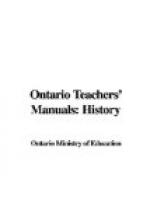The last point—the construction of the Union Jack—should be preceded by a series of lessons on the individual “jacks.” These lessons should explain the significance of the term “jack”; should give the stories of St. George, the patron saint of England, of St. Andrew, the patron saint of Scotland, and of St. Patrick, the patron saint of Ireland; and the reasons for the placing of the crosses on the jacks of the several countries. (See Appendix.)
These lessons may be taken as follows: that of the “jack” and “St. George” after a lesson on the Crusaders; of “St. Andrew” after the lesson on the Battle of Bannockburn; of “St. Patrick” after the lesson on the Conquest of Ireland by Strongbow.
The opposite course may be followed. The construction or drawing of the flag may be taken in connection with one of the flag days; then the children will be interested in the work itself. The story of the jacks may be given afterwards in the history lessons.
As desk work following each lesson, the pupils should construct the flags, using coloured paper, and these flags should be kept for use in the final lesson. The following sizes may be used in oblong flags:
For St. George’s—white
ground—2-1/2 in. x 5 in., red cross 1/2
in.
For St. Andrew’s—blue
ground—2-1/2 in. x 5 in., white cross 1/2
in.
For St. Patrick’s—white
ground—2 1/2 in. x 5 in., red cross 1/3
in.
When the story of the union of the crowns of England and Scotland in the reign of James I has been taught, the pupils should be asked to attempt the problem of uniting the two flags into one. For this purpose the flags already made can be used. The flag of England will surmount that of Scotland, and in order that the flag of Scotland may be seen, the white ground of the flag of England must be removed, only a narrow border of white along each arm being retained to represent the ground colour. This narrow border on each side is one third of the width of the red cross.
The final lesson, the construction of the Union Jack of our day, should be given on Empire Day or a few days before. As an introduction the teacher should review the flag of each country in the Union, referring also to the Union Jacks of James and of Anne. The problem of uniting the Irish Jack with the other two might be given the pupils; but as they are not likely to succeed in solving it, it will be better for the teacher to place before them the Union Jack belonging to the school and to lead them to observe:
1. that it is usually
oblong—twice as long as wide; (it may also
be square);
2. that the St. Andrew’s
Cross is partially covered by the St.
Patrick’s;
3. that the St. George’s
Cross, as before, is one fifth of the
width of the jack;
4. that along the side
of the St. Patrick’s Cross is a strip of
white;
5. that this strip of
white and the red of the St. Patrick’s equal
the broad white of the
St. Andrew’s;




